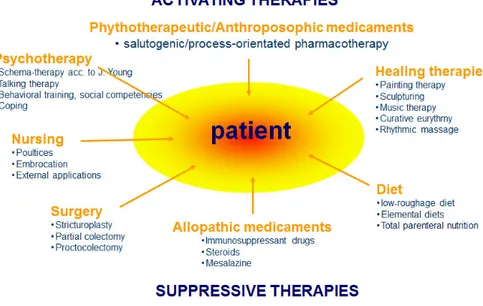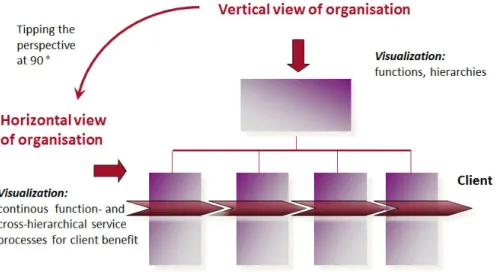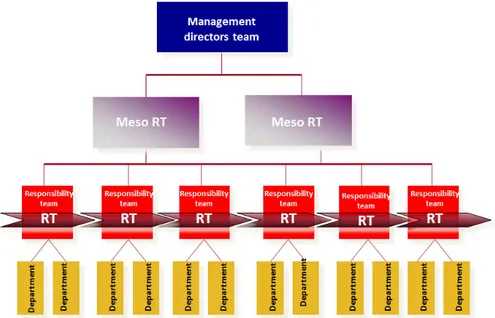Organisational development from a
community hospital to an
anthroposophic-integrative hospital:
The way of Gemeinschaftskrankenhaus
Havelhoehe in Berlin
Harald Matthes
Head of the Department of Gastroenterology and Medical Director at Havelhöhe Community Hospital, specialist in internal medicine, gastroenterology/ oncology and psychotherapy.
E-mail: harald.matthes@havelhoehe.de
This paper describes the extensive change management process of Ge-meinschaftskrankenhaus Havelhoehe in Berlin, Germany, from a community hospital practicing mainstream medicine to a patient- and employee-cen-tered hospital offering integrative Anthroposophic Medicine. A radical reor-ganisation of the hospital structure from a hierarchical to a flat organization was the central change process, resulting in the implementation of an inno-vative leadership-model on a micro and meso management level. In parallel, a comprehensive training of the medical staff in Anthroposophic Medicine as well as in-house trainings in hospital management and leadership for the members of the newly established interprofessional and interdisciplinary ‘re-sponsibility teams’ were effective strategies in the change process. The suc-cess of this change could be shown in a high ranking in patient satisfaction surveys, in an increased economic efficiency, involving having the highest regional growth regarding number of patients, effective cost weight, budget and a significant reduction of length of patient stay.
Introduction
Anthroposophic Medicine (AM) is an integrative approach which combines conventional with complementary therapies, providing “best practice“ medicine. In Germany and Switzer-land, anthroposophic hospitals are completely integrated into the public health care system and provide regio-nal health care service.
Until 1995, Gemeinschaftskranken-haus Havelhoehe (GKH) was run as a conventional community hospital; at that time it operated under the name “Hospital Spandau“. On January 1, 1995, the hospital and all of its staff were merged into an anthroposophic association to implement Anthro-posophic Medicine. As health care mandate for the anthroposophic Hos-pital Havelhoehe, the Senate of Berlin defined not only the narrow region of Spandau (district in the north of Berlin) but also the whole region of Berlin, with the aim to establish a Berlin-wide pluralistic health care tem providing different medical sys-tems in the stationary hospital sector. Health care diversity could not be ac-hieved solely by different world views of hospital owners, because, despite different spiritual approaches, e.g. confessional and communal, they pro-vide the same mainstream medicine. Therefore, in 1995, it was declared the political will of all parties in the Berlin House of Representatives, to establish AM as an integrative medical system in the hospital sector. This political decision was not least the consequen-ce of the increasing demand by the general public for CAM. According to
broad surveys in Germany, 60-70% of the general public demand a supply of integrative medicine (1).
A central approach of AM is the dif-ferentiated multilayer system, which integrates life processes and psychic and spiritual aspects of the human be-ing in diagnostics and therapies.
Besides the pathogenetic concept of conventional medicine, the saluto-genic concept of Aaron Antonovsky plays an important role in AM. Here, disease is understood as a deficit of self-regulation of the organism. Con-sequently, healing will be achieved by stimulation and development to in-crease the capacity of self-regulation. In contrast to pathogenic concepts where the therapeutic principle of substitution and suppression predo-minates, in salutogenic approaches stimulation and excitation (naturopa-thic stimulus-response-model), indivi-dual development and self-regulation are the main therapeutic principles. A central aim is to activate individual resources to increase the self-healing forces, which can be trained and deve-loped by specific interventions.
Using the example of GKH, this paper describes the change from a conventional community hospital to an integrative hospital working with AM.
Methods
AM is a holistic integrative medical system and is based on a humanistic view of man in diagnosis and thera-py, considering all three dimensions (body, soul, spirit) of the human being. As an example, in
anthropo-sophic nursing not only somatic care is performed, but also the stimula-tion of the healing forces by poultices and compresses, rhythmic liniments, manual therapies (massage, foot and organ embrocation) and baths (oil dispersion bath, hyperthermy baths etc.). Physicians’ diagnostic encom-passes the somatic level as well as the psychosocial and spiritual dimension. Besides the use of pharmacotherapy (allopathy and use of anthroposophic remedies and phytotherapeutics), non-pharmacological therapies are an important part of anthroposophic medicine. Depending on the diffe-rent indications, movement therapy (eurythmy therapy), art therapy (pain-ting, music, sculpture therapy and creative speech), biography work and
psychotherapy are used.
The aim of the AM comprehensive therapy approach is to activate and coordinate the different dimensions of the human being to strengthen the healing process. On the therapeutic level, this requires a close team work of nurses, therapists, and physicians. The different professions must bring together their specific perceptions of the patient to jointly combine them into a comprehensive, individual pic-ture of the patient. This central pro-cess, which puts the patient at the cen-ter, takes place in so called “therapy conferences“, where nurses, therapists and physicians meet and develop an agreed multimodal therapy concept for each patient. Besides professional competence, a high level of team
ganisation and social competence are also required from the interdiscipli-nary therapeutic team (Fig. 1).
The organisational structure of conventional hospitals in Germany is mostly characterised by a top-down hierarchy with a typical profession-related pyramid (director of adminis-tration/CEO and clinical director and nursing director, usually not having equal rights with the CEO). However, this structure impairs interprofessio-nal team-building and promotes pa-rallel work of the different occupatio-nal groups. This top- down hospital structure is also reflected in the clas-sical differentiation in departments and divisions. Often a patient has to cross several different wards from ad-mission to discharge, e.g. emergency ward, radiology, endoscopy and sur-gery, which thus tends to undermine patient-centered treatment.
The aim of the extensive change management process in Gemein-schaftskrankenhaus Havelhoehe was therefore to provide a patient-orien-ted hospital organisation and to build partially autonomous interprofes-sional and interdisciplinary therapy teams. In parallel, all 650 employees of the community hospital had to be qualified in AM.
Results
The first step of the change manage-ment process was to replace the clas-sical CEO-position by an interpro-fessional hospital management team, including the director of administra-tion (businessman and physician), the nursing director, a mandated
th-erapist, the medical director and the head of financial control, all having equal rights as hospital management directors. All essential decisions had to be agreed upon through common consent.
When the hospital operator chan-ged in 1995, the GKH had 318 beds in the internal medicine departments (general internal medicine, pneumo-logy, addiction medicine and intensive care), surgery, neurology, anesthesia and radiology. Since then, the spec-trum of medical disciplines (and the number of beds) has grown continu-ously:
• 1995 The internal medicine clinic was extended by Cardiology, Gastro-enterology and Oncology.
• 1996 Department of Gynecology 1998 Obstetrics.
• 1995 Palliative Care Unit.
• 2006 Visceral Surgery as a main spe-cialty in surgery.
• 2002 MIC-center.
• 2002 Department of Psychosomatic and Psychotherapy with 35 beds • 2010 The Addiction Medicine Ser-vice was extended and differentiated into illegal drugs and alcohol and medicament addiction.
• 2012 Department of Multimodal Pain therapy.
• 2013 Geriatrics.
• 2014 Certified Oncology Centre (OnkoZert®) with breast cancer cen-tre, colorectal centre and lung cancer centre.
• 2016 Multimodal Pain Therapy ward enlarged with 20 beds.
• 2016 Supportive oncology (early pal-liative care service) 12 beds palpal-liative care enlarged with 20 more beds.
• 2016 Psychosomatic day hospital for 15 patients.
Workshops and practical teaching of the staff were important measures for the successful implementation of integrative medicine in the communi-ty hospital. However, during the first years, the motivation and willingness of the employees to attend intensive further education in anthroposophic medicine was low. This changed at the point when the change manage-ment concept was adopted and the wards could autonomously decide if they wanted to practice AM and con-ventional medicine in parallel. Sub-sequently, some disciplines ran two competing wards (e.g. gastroentero-logy, cardiology), one practicing AM, the other continuing conventional medicine. The patients then started explicitly requesting AM wards more frequently, resulting in a significantly worse bed occupancy of the conven-tional wards. Triggered by this pa-tients‘ vote, the employees gained an intrinsic interest in AM, because they did not want to perform second class medicine. Suddenly the hospital ow-ner was requested by the employees to offer more intensive education in AM. Hence, in the end it was not the pressure from top down (hospital ma-nagement, owner), but the power of bottom up forces (patients‘ vote with their feet) that induced an interest and requests for education in AM in all oc-cupational groups.
Parallel to the effort to implement AM into the hospital, the change ma-nagement process aimed at a change of the organisational structure to put the patient at the center of the
treat-ment process. Already in the 1970s, the car industry Toyota was the first to recognize that a vertical top-down structure conflicts with the horizontal production line assembly process of a car, and creates extensive interface problems: The three management-‚‘sins‘ the so-called three M’s (Muda = waste, Mura = unevenness and Muri = overburden) were identified. In analogy to the horizontal production process in the car industry, the flow of patients in a hospital can be seen as a horizontal service process with a linear succession of pre-stationary treatment – basic diagnostics – ad-mission – diagnostics – therapy con-cept – treatment – discharge – post-stationary treatment / rehabilitation etc. Interface problems and competi-tive interests exist in a hospital on va-rious levels, e.g. in functional areas of surgery, radiology, endoscopy, heart catheter. They all intend a smooth run but have to manage their own proces-ses within numerous other procesproces-ses like nursing, therapeutic applications, ward rounds, physiotherapy, art thera-py etc.). Among all these challenges during the treatment processes it se-ems to be nearly an unattainable ideal to also coordinate the patient inte-rests, e.g. time of meals, short fasting-phases etc.
The organisational development to patient-centered care was implemen-ted with the external support of Tri-gon® management and organisation development consultancy.
In a first step, we analysed the pro-cesses related to the most frequent diseases treated in our hospital, with a focus on the patient flow from
ad-mission to discharge throughout the different wards and functional areas during their hospital treatment. Sub-sequently, we arranged interdiscipli-nary and interprofessional conferen-ces for all involved parties. The aim was to describe the optimal flow from the patients’ view. In the next step, we derived a concrete process description to perform an optimal patient-cente-red treatment process and evaluated its feasibility.
As a result, clinical pathways were generated, which described not only medical requirements but also the co-ordination of diagnostics and therapi-es between the different departments and divisions. A “side effect“ of this interdisciplinary and interprofessional work was the establishment of
so-cal-led competence centers, e.g. “Interdi-ciplinary Wound Care Management“ (plastic surgery, internal medicine, di-abetology, surgery and dermatology), “Continence Center“ (gastroenterolo-gy, uro-gynecolo(gastroenterolo-gy, visceral surgery) or “Interdisciplinary Pain Therapy“ (anesthesia, psychosomatic, internal medicine, addiction medicine).
The hospital-wide‚ organisational development workshops were held at least four days a year. In between, multiple meetings of the single com-petence centers were held. The degree of attendance at the hospital-wide meeting was 10% of all employees and this had a tremendously stimulating effect on the social contact.
Besides a patient-centered organi-sational development, we focused on
Fig. 2: Change of the employees‘ perspectives, to optimize the horizontal process for patients in hospital
employee motivation and capacity building. An essential sign of quality in therapeutic relationships is the ca-pacity of every employee to autono-mously shape the relationship and take responsibility for their own per-formance.
Furthermore, the claim of inte-grative medicine requires additional competencies and an increased com-mitment of every employee, because they have to know and use both medi-cine systems: conventional and com-plementary methods.
The most important factors in strengthening employee motivation are (according to Herzberg), (2,3), taking responsibility and room to maneuver, recognition, intrinsic self assessment and self fulfillment (Mas-low), (4),. To reach a bottom-up struc-ture with optimal conditions for em-ployee motivation a further 900 turn of the organisation had to be achieved (after the first 900 turn from a verti-cal hierarchic structure to horizontal patient-centered processes) (Fig. 2).
A self-governing structure with functional and integrative elements of leadership (5) as well as the Trigon 3-chefs-leadership model with separa-tion of medical, social and economic responsibility was established and these functions were transmitted to so called “responsibility teams“. The-se responsibility teams manage two or three cooperating wards (e.g. gastro-enterology and visceral surgery) and consist of physicians, nurses and the-rapists working on these wards (micro management). A meso management level was also introduced, where two further so called “meso
level-respon-sibility teams“ (Meso A and Meso B) are concerned with the strategic plan-ning processes of several divisions. They work at the interface micro-le-vel (responsibilty teams) and clinical management directors team (macro level) (Fig. 3).
Employees, working in the re-sponsibility teams, attended in-house training in hospital management and leadership by Trigon®. Since 2007 about 100 employees were trained in four seminars, each around 250 hours.
The success of the organisational development was first seen in 2006, when GKH achieved the first rank in a German-wide patient survey about their experience during their hos-pital stay and treatment. The survey was conducted by one of the biggest health insurance companies in Ger-many (TK = Techniker Kranken-kasse) and included 2100 hospitals and >200.000 patients. It included five categories of questions, like ge-neral satisfaction, outcome, nursing, information and communication, or-ganisation and accommodation. Since then GKH keeps ranking among the top 10.
In 2011 Hospital Havelhoehe re-ceived the KTQ-Award for its inno-vative personnel management, also as a result of the comprehensive change management processes.
The output of GKH increased enormously from its start in 1995 up until 2015: the number of patients increased from 5 500 to 12 900 pa-tients a year and the average length of stay was cut in half from 15,9 to 7,9 days. Since the introduction of the
Fig. 3: Organisational structure tipped to 180 degrees: Bottom-up organisation with interdisci-plinary and interprofessional “Responsibility Teams (RT)“. According to the delegation prin-ciple, manned responsibility teams RT’s (= responsibility teams), Meso-RTs (= division) and directors team (hospital management). All bodies are elected by employees for 3 to 5 years.
DRG system in 2005, the effective cost weight increased from 7 800 to 15 200 in 2015. In the period 1995-2015, GKH was the strongest-gro-wing hospital in Berlin and Branden-burg.
Discussion
Increasingly, patients demand inte-grative medicine. Anthroposophic Medicine represents that kind of ho-listic integrative medical system and is the only integrative medicine system in Germany, which is completely in-tegrated into the regular health care
provision system.
The successful change management in GKH is shown not only in high patient satisfaction but also in an in-creased economic efficiency, having the highest regional growth regarding number of patients, effective cost weight, budget and a significant re-duction of length of patient stay.
The path taken by GKH could serve as a “best-practice-example“ for a successful implementation of a comprehensive change management process in a hospital. In particular by implementing innovative
leadership-Literature
1. Piel E. Naturheilmittel im Spiegel der Demos-kopie. Einstellungen und Verbraucherver-haltenim Trend. PraxisMagazin Die medizi-nische Fachzeitschrift für Naturheilkunde. 2007;24(6):24-28.
2. Herzberg F, Hamlin RM. The motivation-hy-giene concept and psychotherapy. Ment Hyg. 1963;47:384-397.
3. Herzberg F, Hamlin RM. A motivation-hy-giene concept of mental health. Ment Hyg. 1961;45:394-401.
4. Maslow A: A Theory of Human Motiva-tion. In Psychological Review, 1943, Vol. 50 #4, Seite 370–396. Psychological Review. 1943;50(4):370-393.
5. Glasl F, Kalcher T, Piber H. Professionelle Pro-zessberatung: Das Trigon-Modell der sieben OE-Basisprozesse. 3 ed. Stuttgart: Verlag: Freies Geistesleben; 2014.
models (responsibility teams), GKH developed from a community hospi-tal, practicing mainstream medicine, to a patient- and employee-centered hospital, offering integrative medicine with excellence regarding patient sa-tisfaction.


